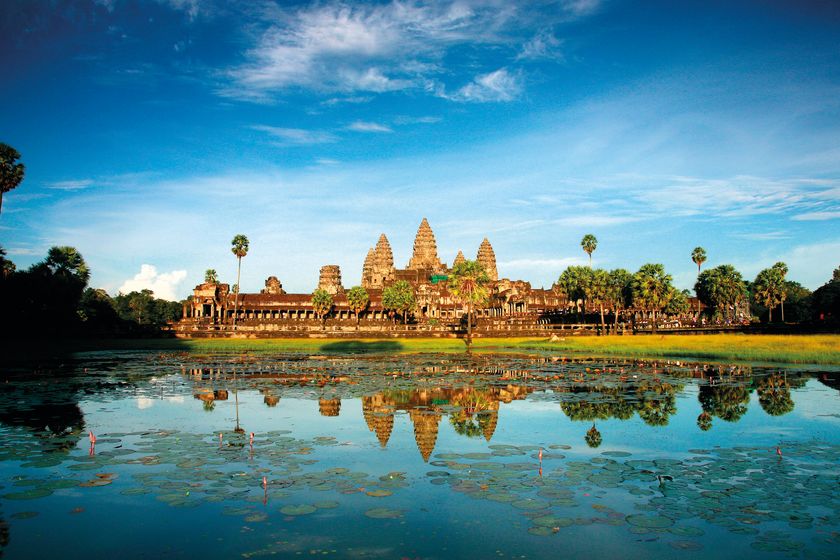Introduction
Cambodia's capital Phnom Penh is sprawling, vibrant and often chaotic, a compelling mixture of old and new.
Wide boulevards and Parisian-style cafes stand alongside Buddhist temples and bustling street markets, scooters and tuk tuks adding to the bustle of a place often thought of as a frontier town.
Its strategic importance has long been recognised, located as it is at the confluence of the Tonlé Sap and Mekong rivers, and in the 15th century it became the capital of the Khmer empire when it relocated from Angkor.
More recently, in 1975, Phnom Penh's citizens were driven out by Pol Pot's forces to the infamous Killing Fields, an event that still scars the national consciousness. Painful as this memory remains, the city - once known as the Pearl of the Orient - is now regaining its old allure.
At the heart of an increasingly confident city is the enticing Sisowath Quay area, lined with French restaurants and local eateries, bookshops and boutiques, and the departure point for river cruises down the Tonlé Sap and Mekong river.
Royal Palace & Silver Pagoda
The Royal Palace, similar in style to the Grand Palace in Bangkok and full of Buddhist treasures, is a quintessential Khmer palace. Stood on the banks of the Tonlé Sap River it's one of Phnom Penh's major highlights.
The official home of the Cambodian monarch, its Throne Hall features scenes from the Ramayana on its ceiling and has a striking 59-metre central tower, whose design takes inspiration from Angkor's Bayon temple.
Garudas (mythical beasts, half-man, half-bird) and nagas (serpents) adorn the gilded roof, and elegant stupas, spires and gateways abound.
Within the palace complex is the Silver Pagoda, a compound of ornate statues, murals and buildings containing sacred texts.
The pagoda, which also houses the famous Temple of the Emerald Buddha, (Wat Preah Keo) takes its name from the 5,000 silver blocks that line its floor.
National Museum of Cambodia
Four imposing terracotta pavilions with tiered roofs and central spires make up the National Museum of Cambodia and contain the nation's greatest display of Khmer art and relics.
Ceramics, carved wooden objects, bronzes and statues are among the wealth of exhibits from before, during and after the Angkor period - among them a statue of the eight-armed Hindu god Vishnu and another of the 12th century Angkorian ruler Jayavarman VII.
Wat Phnom, Wat Botum & Wat Ounalom
Worshippers, mischievous monkeys and street hawkers contribute to the general hubbub at Wat Phnom, a hillside temple guarded by stone nagas and lions that gives the city part of its name - the other part is attributed to Penh, a rich Khmer lady who built this pagoda in 1372 as a place in which to store four sacred statues of the Buddha.
The pagoda has been rebuilt several times but remains the city's tallest religious structure.
Other important temples include Wat Botum, where many prominent dignitaries are buried, and Wat Ounalom, built in 1443 to house a hair of the Buddha and now the headquarters of the Cambodian Buddhist sangha (order).
Tuol Sleng Genocide Museum
Understanding the tragic recent history of Cambodia is the reason to visit the memorable but unsettling Tuol Sleng Genocide Museum, housed in a school that was subsequently turned into the Khmer Rouge's notorious S-21 interrogation centre.
Here, some 17,000 men, women and children were held and tortured before being taken to the extermination camp and Killing Fields of Choeung Ek.
When Vietnamese liberators entered the city in 1975 only seven people were still alive at S-21. Diaries, poems and photographs of the prisoners who passed through Tuol Sleng are among the haunting exhibits.
The Killing Fields
The Killing Fields of Choeung Ek lie in a deceptively peaceful setting amongst orchards and rice fields.
Here, 15 kilometres from Phnom Penh, the Khmer Rouge exacted its dreadful genocide - murdering the many thousands of prisoners it had interrogated and tortured at Tuol Sleng.
The victims were buried here in mass graves. A pagoda containing the cracked skulls of many of the dead is a powerful reminder of the atrocities.












